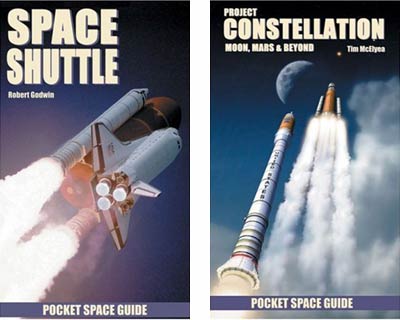|
|
Review: Space transportation systems, present and future
by Jeff Foust
Monday, March 19, 2007
Space Shuttle Fact Archive
by Robert Godwin
Apogee Books, 2007
softcover, 96 pp., illus
ISBN 1-894959-52-3
US$9.95
Project Constellation: Moon, Mars & Beyond
by Tim McElyea
Apogee Books, 2007
softcover, 96 pp., illus.
ISBN 1-894959-49-3
US$9.95
NASA is undergoing what is arguably its biggest transition since the end of the Apollo program and the beginning of the Shuttle program over 30 years ago. Now it’s the Shuttle’s turn to go the way of the Saturn 5 rocket and Apollo spacecraft, to be replaced by something that combines some elements of both of its predecessors. This makes the present as good a time as any to both look back at the Space Shuttle and look ahead to the new generation of spacecraft and launch vehicles, which Apogee Books does in capsule form—pardon the pun—with two of its latest pocket guides.
Space Shuttle Fact Archive is just that: a concise summary of the Shuttle program and the 117 flights by the fleet of orbiters to date. The front section of the book provides a summary of the technical details of the Shuttle system, including information about each of the five orbiters (excluding Enterprise) and the Spacelab and SPACEHAB modules that have been flown on a number of missions, as well as lists of the astronauts who have flown on Shuttle missions and the satellites that have been launched on those missions. The tail end of the book includes a handful of color photos of shuttles in various phases of missions, from rollout through launch to landing. In the middle is arguably the heart of the book: 39 pages that provide a brief summary of every shuttle mission to date, from STS-1 in 1981 to STS-116 at the end of 2006. Given the limited space available, these summaries are really at-a-glance overviews of each mission, featuring the official mission portrait and patch, the list of crew members, and a one-line coded summary with the mission name, launch and landing dates, orbiter used, and icons to identify what took place on the mission: a visit to the ISS, the launch of a satellite, et cetera. If nothing else, it’s interesting to flip through those pages to see how the missions, and their crews, have changed over the last quarter-century.
| McElyea warns in Project Constellation that “Describing an evolving program is much like describing a lava lamp or clouds in the summer sky.” |
Project Constellation takes its name from the underused designation for the Orion spacecraft and Ares launch vehicles that will replace the Shuttle and—if all goes well from a technical and budgetary standpoint—send humans back to the Moon. This book provides an overview of the Orion and Ares programs, going into some technical detail about key components, such as the engines that will be used. About half the book is text and diagrams covering the development of these systems, with the second half reserved for color photos and illustrations of these vehicles. Given that the overall Constellation program is a moving target, with shifting details and deadlines—as seen as recently as last week, when NASA administrator Michael Griffin told Congress that the first manned Orion flight was now scheduled for March 2015, considerably later than previously planned—Tim McElyea has done a good job keeping on top of these changes, within the limitations of the book publication cycle. He includes, for example, a reference to an internal NASA study of an “Ares 4” launch vehicle that could be used in place of both the Ares 1 and Ares 5 for lunar missions, a study that only became public earlier this year.
McElyea is aware of the dynamic nature of the Constellation program, and includes an author’s note at the beginning of book where he states, “Describing an evolving program is much like describing a lava lamp or clouds in the summer sky. One can describe it in generalities and be reasonably accurate but the closer one gets to describing the details the greater the potential becomes for inaccuracies over time.” That is certainly the case for Constellation, which could face even bigger changes in two years’ time, after a new president takes office and decides to put his or her stamp on the space agency. In any event, Project Constellation provides a brief but illuminating snapshot of the current state of the program, just as Space Shuttle Fact Archive gives a summary of the essential facts about the system to be replaced by Constellation.
Jeff Foust (jeff@thespacereview.com) is the editor and publisher of The Space Review. He also operates the Spacetoday.net web site and the Space Politics and Personal Spaceflight weblogs. Views and opinions expressed in this article are those of the author alone, and do not represent the official positions of any organization or company, including the Futron Corporation, the author’s employer.
|
|
